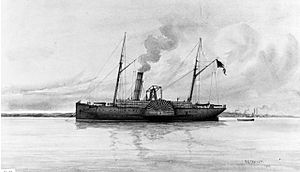Governor Moore (gunboat) facts for kids
class="infobox " style="float: right; clear: right; width: 315px; border-spacing: 2px; text-align: left; font-size: 90%;"
| colspan="2" style="text-align: center; font-size: 90%; line-height: 1.5em;" | 
|}
The CSS Governor Moore was a special kind of steamer used by the Confederate States Navy during the American Civil War. It was built in 1854 and was originally a schooner-rigged ship.
Contents
| History | |
|---|---|
| Name | CSS Governor Moore |
| Namesake | Thomas Overton Moore |
| Launched | 1854 |
| Commissioned | 1862 |
| Decommissioned | 24 April 1862 |
| Fate | Disabled by enemy fire, destroyed to prevent capture |
| General characteristics | |
| Displacement | 1215 tons |
| Propulsion | Steam engine |
| Complement | 93 officers and men |
| Armament | 2 32-pounder rifled cannons |
| Notes |
|
About the CSS Governor Moore
The ship was first named Charles Morgan and belonged to the Southern S. S. Company. It was built in New York City in 1854. This ship was a steamer with a special "walking beam" engine, designed for ocean travel.
Becoming a Confederate Gunboat
In January 1862, Brigadier General Mansfield Lovell of the Confederate States Army took control of the ship in New Orleans, Louisiana. It was then renamed Governor Moore after Thomas Overton Moore, who was the Governor of Louisiana.
To make it a fighting ship, its front (stem) was made stronger for ramming other ships. Workers added two strips of railroad iron at the waterline. They also put pine lumber and cotton bales around its boilers to protect them from enemy fire. Even with these changes, Governor Moore was never officially part of the Confederate States Navy.
A Cotton-Clad Ship
The Governor Moore was one of two large "cotton-clads" owned by the State of Louisiana. Cotton-clads were ships protected by bales of cotton, which could absorb enemy cannon fire. For some time, Lieutenant Beverly Kennon commanded the ship. He served in the Louisiana Provisional Navy without pay.
The Battle of New Orleans
The Governor Moore became famous during a big battle on April 24, 1862. On that day, Admiral David Farragut of the United States Navy led his fleet past Fort Jackson and Fort St. Philip. His goal was to capture New Orleans.
Governor Moore's Brave Fight
During the battle, the Governor Moore fought fiercely. It rammed the Union ship USS Varuna two times. Another cotton-clad ship also hit Varuna, forcing it to run aground.
Next, Governor Moore attacked USS Cayuga. This put Governor Moore in the path of many Union ships' cannons. The ship was hit many times, and most of its upper parts were shot away. Sixty-one men on board were killed or dying.
The Ship's Final Moments
With so much damage, the Governor Moore could no longer be steered. It drifted helplessly towards the shore. Its captain, pilot, and a seaman set the ship on fire to prevent the enemy from capturing it.
The Governor Moore exploded as these three, along with three other survivors, were captured by boats from USS Oneida. They were taken as prisoners to the USS Colorado. About two-thirds of the crew managed to escape into the nearby marshes. No one drowned during this event.
A Symbol of Courage
Lieutenant Kennon later wrote about the battle from the Colorado. He said that the ship's flags were never taken down. He wrote, "The flames that lit our decks stood faithful sentinels over their halyards until they, like the ship, were entirely consumed." He also mentioned that their flags were shot away three times. He personally raised them twice. In the end, only a small part of the flag with four stars remained, showing how bravely they had fought. The ship sank with Louisiana's colors still flying.
Images for kids
See also
 In Spanish: CSS Governor Moore para niños
In Spanish: CSS Governor Moore para niños


